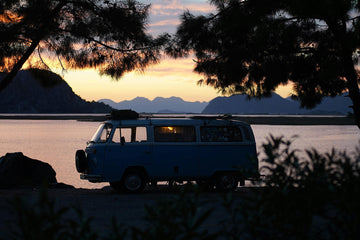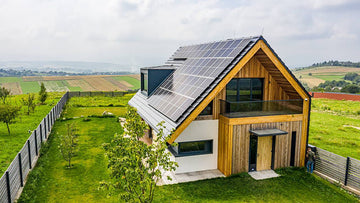Nowadays, camping has become a way of holidaying for many people. At the end of the week, they get away from the hustle and bustle of the city in a fully furnished motorhome or campervan and enjoy the beauty of nature. But there are others who don't have a caravan and don't want to install complicated solar panels; they usually take a small camping trailer or go the old-fashioned way (tent camping). These campers usually want to use simple appliances such as radios, coffee makers, mobile phone chargers and so on. So a small camping inverter and a decent sized battery may be all they need.
Having trouble deciding which inverter is right for your camping needs? Don't worry, this blog will detail the power requirements of different camping scenarios and help you choose the right inverter.
Why do we use inverters in camping?
In order for the equipment and electronics we carry to work properly in the field, we need stable power. An important component in the power conversion process is the inverter.
The first thing we need to do is determine how we might generate power in the field:
- Car battery: If you are accompanied by a vehicle, you can get electricity from the car battery.
- Solar panels: Some campers are equipped with solar panels that generate electricity that is stored in batteries.
- Fuel cells: some portable fuel cells can provide electricity
- Portable generators
The above devices can only provide DC power, while most household appliances require a stable AC power supply to operate. This is where we need to use a power inverter to convert DC power into AC power.
With a stable power supply, we can enjoy the comforts of home when we are camping and charge our mobile phones and computers at any time. At night we can still have normal lighting. We can also use some electric cooking equipment (e.g. electric hot pot, electric pressure cooker) to prepare delicious food in the field.

In addition to understanding the use of inverters in camping, you need to know the two common types of inverters: pure sine wave inverters and modified sine wave inverters.
What size inverter do i need for camping?
Calculating power requirements
First, determine the power requirements of the electronics you need for your camping trip (most appliances will have a product label on the bottom or in an out of the way location). The product label will usually show the manufacturer, model number and power rating of the appliance, then select an inverter that can meet this power requirement (each inverter has its own power rating). Some equipment will have an inrush current at start-up that exceeds the power rating and this should also be taken into account.
Add up the power requirements of the equipment you intend to use at the same time to determine the total power the inverter will need to support. When selecting an inverter, the power rating should be slightly higher than your calculated total power requirement.
Determining the input voltage
Make sure that the input voltage of the inverter matches the voltage of the batteries you are using. Typical domestic batteries are 12 or 24 volts, so the input voltage of the inverter you choose should also be 12 or 24 volts.
In addition to the input voltage and output power, you must also consider the type of waveform of the inverter (pure sine wave or modified sine wave) to ensure that the inverter is suitable for your needs.
Determining the output voltage
Depending on your country/region, the operating voltage of the unit will be different. Please purchase an inverter with the same output voltage and frequency as your country/region, otherwise it will not work.
Different requirements for camping inverters
Long-distance hiking
Long distance trekking requires carrying lightweight equipment to maintain energy independence.
💡Inverter recommendations: 50 to 100W portable inverters that can be connected to solar charging panels or portable battery packs for light charging needs.
Family camping
Families heading to a campsite may need to charge mobile phones, tablets and other small electronic devices.
💡Inverter recommendations: 300W to 500W pure sine wave inverters that can be connected to a car battery or portable generator, suitable for charging small electronic devices and lighting.
Campervan Camping
Camping with a caravan or motorhome requires power for appliances such as fridges, lighting, TVs, etc.
💡Inverter Recommendation: 1000W to 2000W pure sine wave inverters that can be connected to the on-board battery system for medium power appliances.
Camping at an outdoor music festival
Camping at an outdoor music festival requires electricity for sound equipment, lighting and small appliances.
💡Inverter recommendations: 2000+ watt pure sine wave inverters that can be connected to car batteries or portable generators for high power equipment.
Practical tips to improve efficiency:
- Match power requirements: do not over or under power the inverter. Ensure that the inverter is rated at a power level sufficient to support your equipment, taking into account the starting power of the equipment.
- Switch off unused equipment: Switch off equipment when not in use to save battery life.
- Use energy saving devices: LED lights and energy saving fans consume less power.
- Monitor battery level: Check the battery level regularly to avoid power outages.
- Some inverters have an energy saving mode that automatically adjusts the power to the load to save energy.
Things to consider when camping with an inverter
Here we detail some of the problems that camping and caravanning can cause with inverters:
Inverters in cold environments
There are specific issues and challenges that can arise when using inverters in cold environments. In cold environments, the inverter may overheat due to prolonged operation, but at the same time it must be maintained at a certain temperature to ensure proper operation. Therefore, ensure that the inverter is well ventilated and consider using an external radiator or heater to control the temperature of the inverter.
The circuitry and electronics of the inverter are more susceptible to damage in cold environments and the condition of the inverter must be checked regularly.
Bringing the inverter indoors from a cold place can cause condensation on all its surfaces, including the electronic components inside. If this happens, allow the inverter to warm up and dry out for approximately one hour before use. Failure to do so may result in malfunction or damage.
Powering a caravan or motorhome socket
It's often not a good idea to connect an inverter to a caravan or motorhome socket, either directly or indirectly via a connecting cable. A modified sine wave inverter will almost certainly damage the switch mode charger and possibly any sensitive equipment connected to it.
Pure sine wave inverters will not cause damage but can be easily overloaded. Under no circumstances should the output of an inverter be connected to the mains. Ensure that the power rating of the inverter is sufficient for the requirements of the connected equipment and avoid overloading. Failure to do so may result in damage to the inverter or even fire.
Safety precautions
Whether it is the inverter or the mains supply, you should take every precaution to avoid electric shock, especially in humid environments. In addition, when using a modified sine wave inverter, regularly check the equipment being powered for signs of overheating. Incorrect connection of the inverter or equipment during installation may also cause a short circuit or overload of the circuit, increasing the risk of electric shock. If in doubt, disconnect the power and consult a qualified electrician.
Sustainable options: connecting solar panels
Solar power is an infinitely renewable and clean source of energy. Pairing an inverter with solar panels will keep your batteries fully charged and extend your camping trip indefinitely. Just make sure your solar installation can produce enough power to meet your needs. With a one-off investment in solar panels, you can get free electricity for a long time!

Power station with inverter
Portable power stations are becoming increasingly popular in the camping sector as lithium battery technology advances. These portable power stations incorporate components such as lithium batteries, inverters and charge controllers, and not only do they provide you with a convenient off-the-shelf way of connecting all your 12v and USB devices, but they also usually include a suitably sized inverter, so for some people this will be a more convenient option as it can be used in many situations and can be charged via solar, DC or AC electric sockets for charging.

An inverter is an important piece of camping equipment, providing flexibility, convenience and power to your equipment during outdoor activities. Choosing the right inverter for your needs can enhance your camping experience and ensure reliable power for your equipment.
Enjoy your camping trip!

















